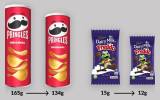
Australian shoppers may be asked to dob in grocery retailers charging top dollar for shrinking products as the federal government looks at ways to curb shrinkflation.
A public consultation began on Monday seeking consumer feedback on the introduction of a “shrinkflation” notification regime to name and shame brands.
It is also proposed that unit price displays be made more readable, with fines imposed on non-compliant retailers.
Assistant Minister for Treasury Andrew Leigh said clearer information meant Australians would be able to spot changes to product sizes and decide if they were value for money.
“If a chocolate bar loses two squares but keeps the same price, that’s not magic – it’s shrinkflation,” Leigh said.
“We want feedback on what steps we can take next to crack down on diminishing sizes.”
Leigh has long crusaded against shrinkflation, previously calling the practice a “cunning trick” by manufacturers that forces consumers to pay more for less.
Examples of shrinkflation include Freddo frogs reducing in size, Tim Tams coming with fewer biscuits in each packet, and breweries making their cans smaller.
Analysis published last year by Deakin University found that cereal has also been subject to shrinkflation, with seven products getting smaller between 2019 and 2024, despite packaging increasing in size.
In the worst case, a product became 150 grams (17 per cent) smaller, with the average decrease being about 4.1 per cent, according to the Deakin figures.
Even Sesame Street character Cookie Monster was moved to tweet about the practice in 2024.
An Australian Competition and Consumer Commission supermarket inquiry report, released in February, recommended that supermarkets publish notifications when product sizes change, but prices remain the same.
Last year, independent consumer advocacy group Choice identified 15 supermarket products that had reduced in size, with the price remaining the same or increasing.
The examples included Coles’ Mighty Grain cereal. It was sold in 560-gram packets in October 2022, but by March 2024 was being sold in 495-gram packages – yet the price remained the same at $4.50. It now sells for $5.
“Comparing unit prices remains one of the most useful tools people have to help save on groceries,” Andy Kelly, Choice deputy director of campaigns and communications, said Monday.
“We’ve received dozens of examples of dodgy unit pricing from Choice supporters, including unit prices that are too small to read, obscured, use inconsistent units of measurement, are completely incorrect or missing altogether.”
University of Technology Sydney’s professor Sanjoy Paul told The New Daily last year it was difficult for customers to avoid shrinkflation because while some products – such as home-brand ranges – could be cheaper, it was difficult to tell how sizes had changed relative to prices unless comparing historic purchases to current ones.
He said the practice happened not just in packaged groceries, but also in fresh food sections of supermarkets.
“Whether it’s cucumber or zucchini, those packet sizes can become 750 grams instead of a kilo,’’ Paul said.
“Not informing customers is very intentional, so that they can increase their profits as much as possible.”










